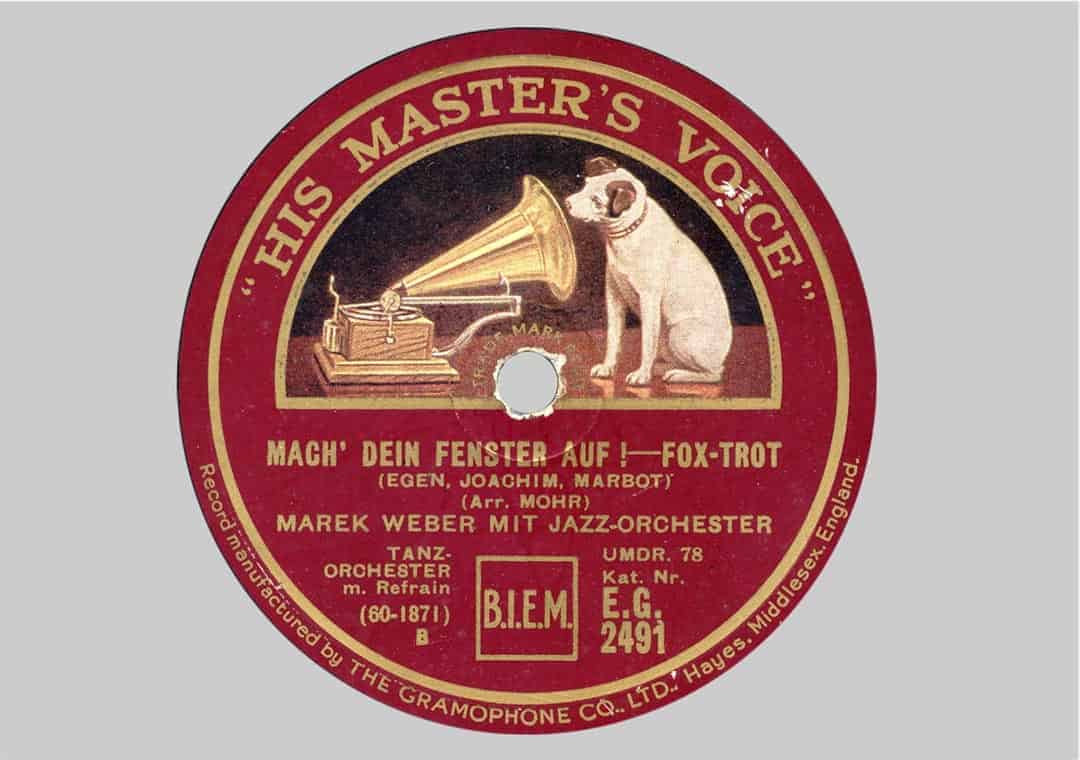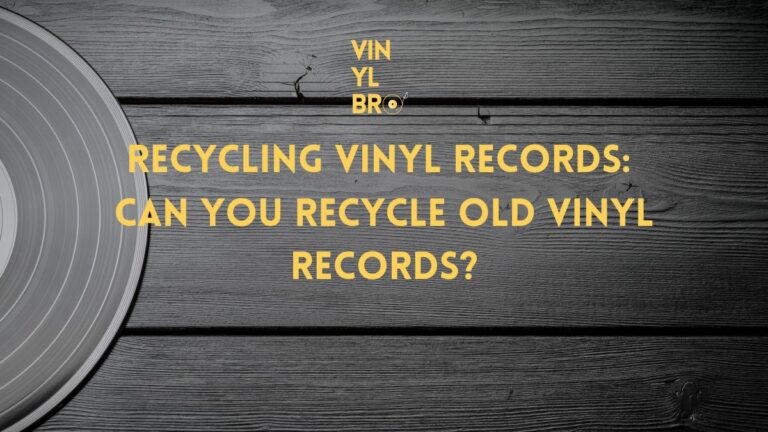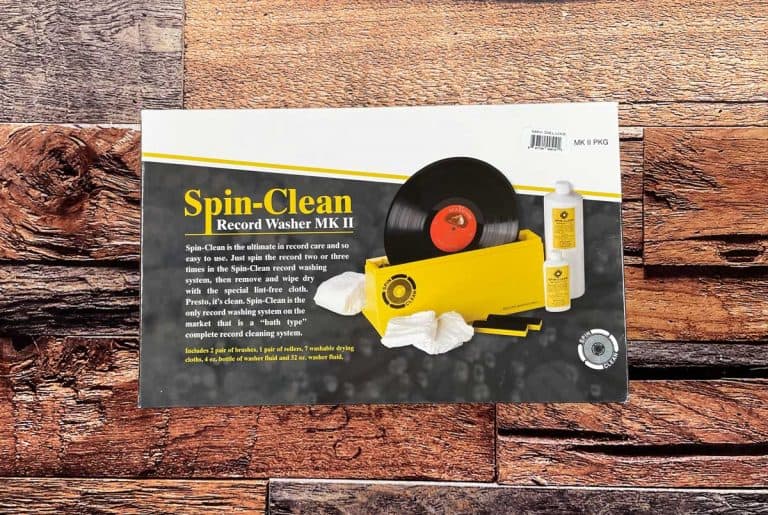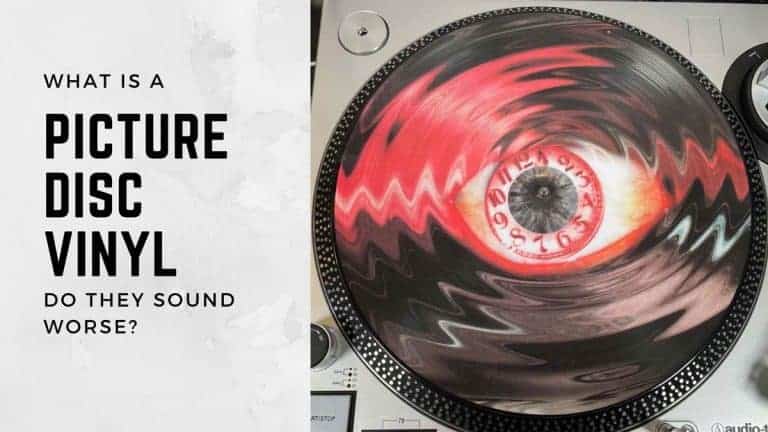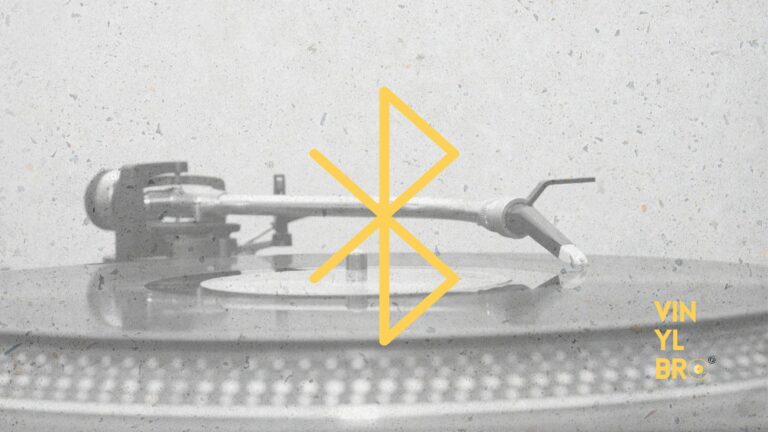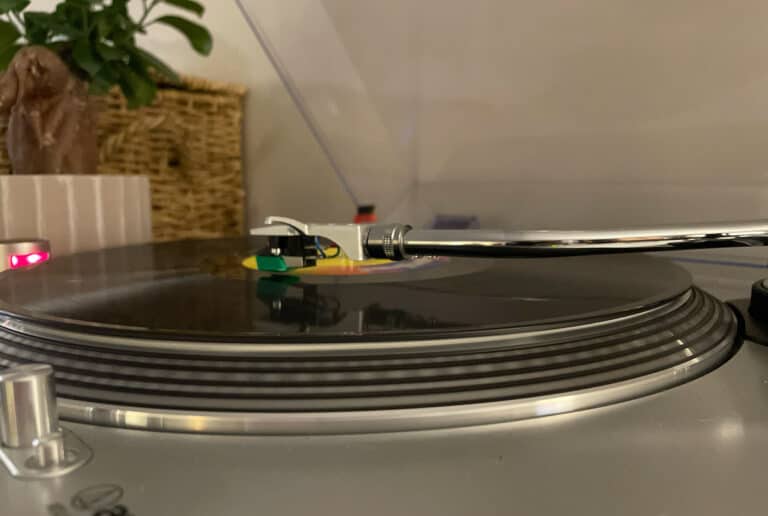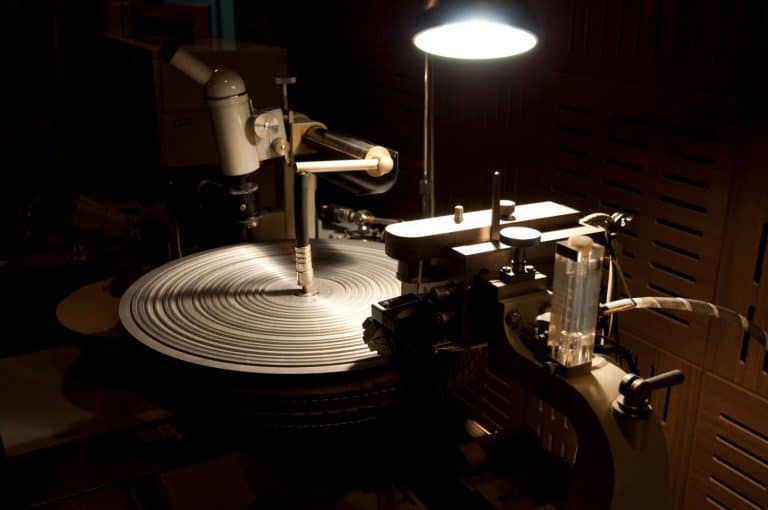The Exhaustive History Of Records And Record Players
We think record players and vinyl records are super awesome and many of you probably agree. The thing is there is a long history behind them and it’s pretty fascinating. We feel like this is one of the many reasons people are drawn to collecting vinyl records. You feel like you are buying a piece of history and an experience.
The History of Records and Record Players (1870s-1900s)
Vinyl records have a long history that starts with the simple idea of recording sound and hearing it played back. There was a time before vinyl records were vinyl and this is where it all starts. We will go back in time to 1877 when the phonograph was invented by Thomas Edison.
The Invention Of The Phonograph
This invention is said to be Edison’s most favored invention. He even set aside his most famous invention, the incandescent light bulb, just to work on this invention. The whole concept of a device you can record and hear back came from his idea of creating a telegraph repeater he was working on inventing. During this process he experimented with different types of materials to use, starting with a wax impregnated paper called paraffin paper.
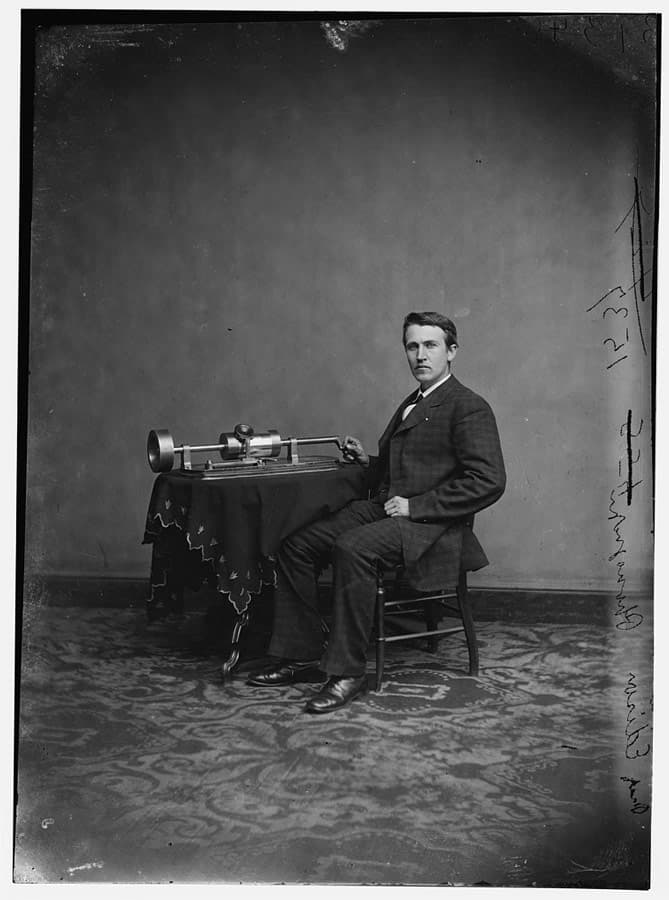
Originally the phonograph was used as a dictating device but quickly became used for entertainment purposes. The way this invention roughly worked was upon speaking into the mouthpiece, shaped like a horn, the vibrations made indentations in the paper. Edison quickly ran into the limitations of the paper as playback was difficult and switched to using metal and tinfoil cylinders.
When Thomas Edison created this new machine with metal and tinfoil cylinder disks he upgraded it a little bit. With this new machine, he added an extra set of diaphragm and stylus to the design. One stylus, or needle, was used to record sound while the other was used to playback sounds recorded into the cylinder. The very first ever recording made and playback was Thomas Edison speaking the children’s rhyme Mary Had A Little Lamb.
Itching to show off his invention, Thomas Edison showed the phonograph to the staff at Scientific American in New York City. They reported “Mr. Thomas A. Edison recently came into this office, placed a little machine on our desk, turned a crank, and the machine inquired as to our health, asked how we liked the phonograph, informed us that it was very well, and bid us a cordial good night.” on December 22 of 1877. Thomas Edison then filed for a patent on his phonograph machine on December 24, 1877, which was issued to Edison on February 19, 1878.

Edison opened the Edison Speaking Phonograph Company on January 24, 1878, to start selling the machine. The machine had its shortcomings such as the tinfoil only being good for a few plays, however, it was an instant success. Edison had tons of ideas for uses with this device but ultimately the interest was lost and Edison started working on his famous incandescent light bulb also known as the Edison light bulb.
Ok, so right about now you are thinking “This is great but I thought this was about the history of records and record players?” It is and all of this is the very early beginnings of the evolution that became modern-day vinyl records and record players. Let’s get back to it!
So during this time in which Edison took a break from the phonograph, Alexander Graham Bell and Charles Sumner Tainter began working on the graphophone which was viewed as an improvement over Edison’s phonograph. Bell and Tainter upgraded the device with a floating stylus instead of rigid needles as well as a new type of cylinder made from wax instead of tin foil. Bell and Tainter were given a patent for the graphophone on May 4, 1886. While these two tried to approach Edison to work together, Edison resisted the idea.
The Invention Of The Gramophone
Meanwhile, an inventor named Emile Berliner created a device called a gramophone which used flat discs instead of cylinders. His device was also powered by a hand crank featuring a large horn on top. The discs Berliner used were initially made from glass compared to Edison’s wax. It was until later that he experimented with Zinc.
Berliner’s flat disc and gramophone lacked sound quality compared to Edison’s phonograph. Berliner’s earliest discs were first marketed in Europe in 1889 and were approximately 5 inches (or 12.5cm)
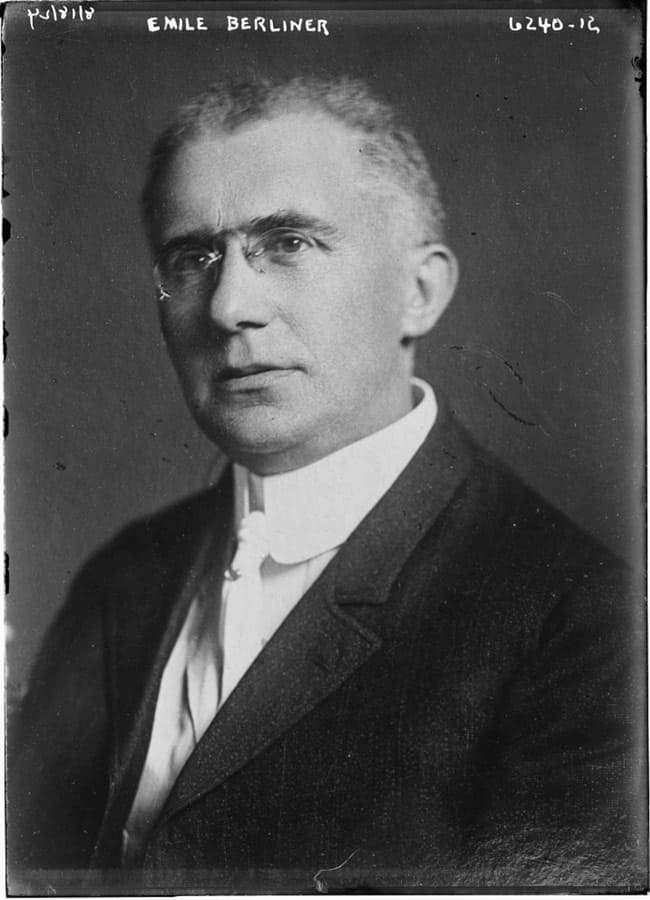
Nearly a decade after he put the project aside for the incandescent light bulb, Edison began working on upgrading his existing phonograph. In the beginning, these upgrades closely matched the upgrades that Bell and Tainter’s graphophone had. The newly upgraded phonograph would be named “New Phonograph”.
Edison opened a new company to market and sell this upgraded phonograph called The Edison Phonograph Company. These New Phonographs and the later Perfected Phonograph used different types of wax cylinders, hence the common name for vinyl as “wax”.
The phonograph companies were bought by a businessman named Jesse H. Lippincott under a business called North American Phonograph Company. Lippincott used and leased the devices as dictating devices until he fell ill in 1890 when Edison took control of the company.
Edison then began offering more offerings with his device as entertainment devices instead of dictating. The idea saw its first product when Edison’s company Edison Phonograph Toy Manufacturing Company produced talking dolls that would playback a sound from a tiny wax cylinder.
In 1894 Edison purposely bankrupted the North American Phonograph Company so he could buy back the rights to the phonograph. In January of 1896 Edison opened the National Phonograph Company so he could produce and sell phonographs for home entertainment use. Alongside his home use phonograph, he was commercially producing cylinders for home use under the company’s label.
While the pricing of the phonographs varied based on their model and features, the standard cylinders were usually 4.25″ long and 2.1875″ in diameter and offered at 120 RPMs. These cylinders were priced at $0.50 each and housed a wide variety of music from marches to hymnals. There were a couple of problems with these cylinders.
- There was no method to mass-produce the cylinders. To produce multiple cylinders of the same song, performers would be required to perform the song or performance over and over.
- The standard cylinders only held around 2 minutes of audio and this would not be fixed until Edison introduced the Concert Phonograph and cylinders which held between 4 and 5 minutes.
This is how production for Edison went for much of the remaining millennia. However, around these times, 1894 to be exact, Emile Berliner began producing and marketing 7-inch diameter flat disc recordings and his gramophone for home entertainment.
The gramophone he introduced for home entertainment played much better and had better sound quality than his previous models. Which helped with the main problem his company suffered from in comparison to Edison’s Phonograph.
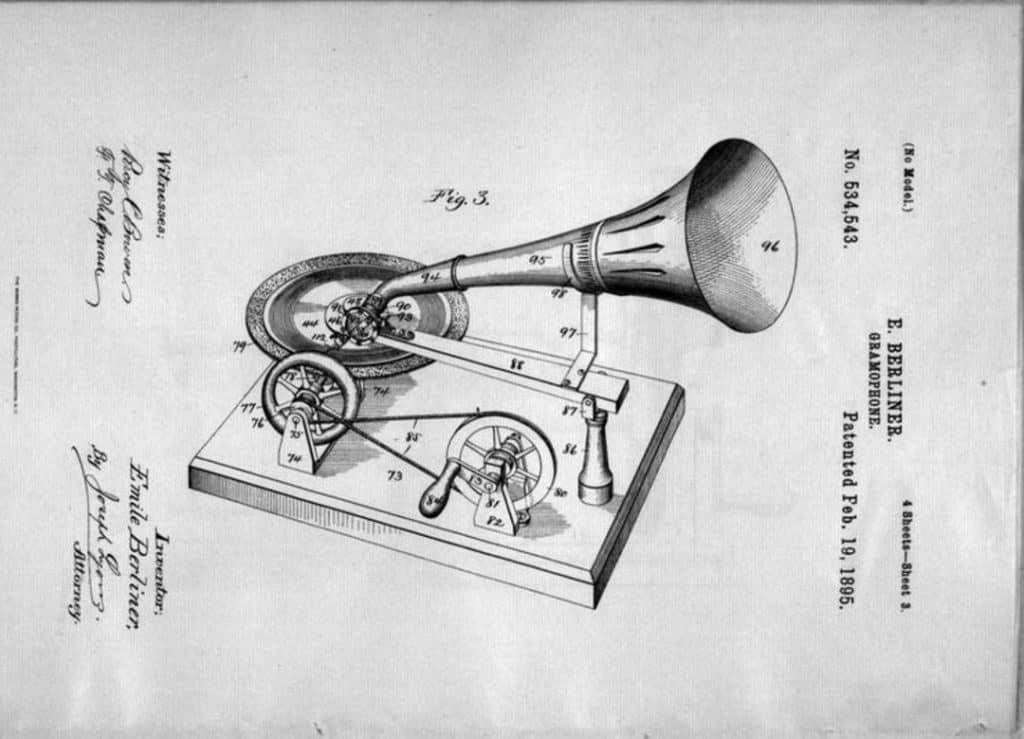
The greatest advantage Berliner had was the fact that flat discs could be much more easily mass-produced. The mass production of these flat disc records was done very similarly to how we produce them now by creating a master recording to create molds with. Each of Berliner’s moldings could press hundreds of discs. The biggest advantage of this was time and cost as he did not need performers there to reproduce the disc.
The Middle History Of Records and Record Players (1900s-1940s)
The 1900s was a big time for records and record players. This is when we start to get to the point where turntables and vinyl start to turn more into what we are used to seeing now.
In 1900-1901 Emile Berliner and his manufacturing partner Eldridge Johnson, who vastly improved the quality of the discs, formed the Victor Talking Machine company out of New Jersey. It was later moved to Montreal, Canada. The interesting part about this move is that the company later became RCA Victor which still exists to this day and they even have a great museum!
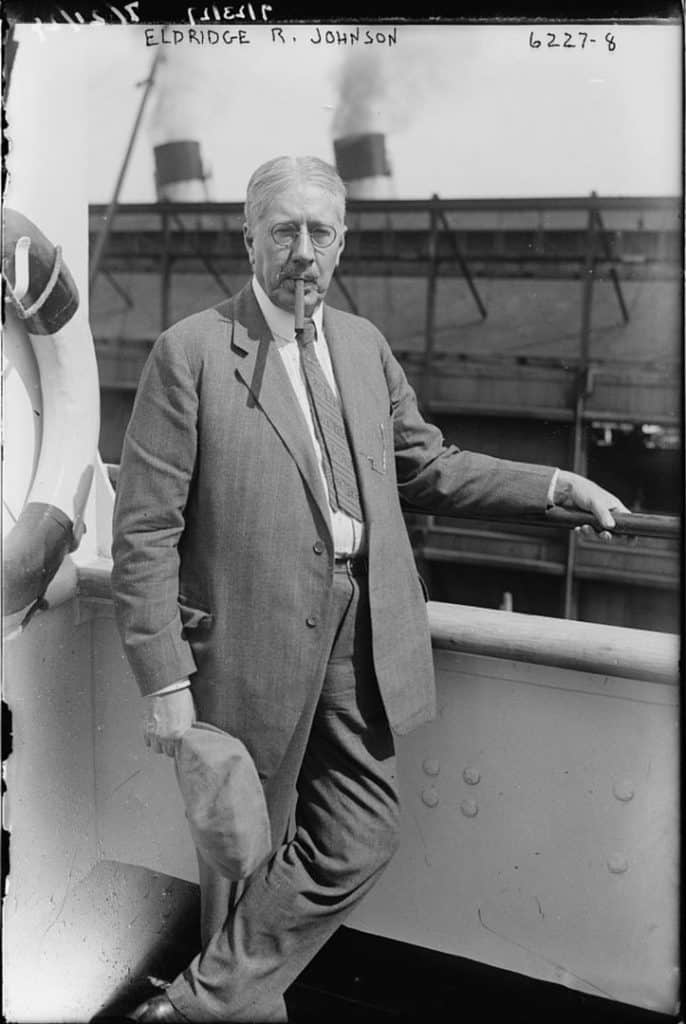
The End Of The Wax Cylinder
The reason this is all-important is that this outlines the beginning of the end for the wax cylinders Edison created. While Berliner and Johnson were seeing success Edison refused to give up on his wax cylinders. In 1901 Edison had found a way of mass-producing his cylinders by molding them instead of the previous engraving which limited the pressings.
The new method consisted of what was called a Gold Master which was used to create sub-masters. Each mold from there could produce around 150 new cylinders a day. As the new manufacturing method lowered the cost of production, the cylinders echoed the price drop.
The ultimate downfall for Edison’s wax cylinders started in 1912 when Edison’s largest competitor Columbia stopped producing cylinders for Edison’s machine. During this downfall, Edison’s team secretly began working on flat discs made from a resinous plastic to rival the sound and style of the shellac records produced by Berliner. The records his team produced were 10-inch records that played at 80 RPM for 5 minutes.
Once Edison discovered what his time was working on he took full control and paid a lot of attention to it personally. In 1912 Edison’s team would introduce their disc phonograph to compete directly with the vastly popular Victrola by Berliner and Johnson’s Victor Talking Machine Company.
The main differences between the devices were that Edison’s disc phonographs were made as cabinets and you had to purchase Edison’s disc as the stylus had a diamond point and the speeds were different. The initial reaction in the market was not good.
In 1913 all other manufacturers stopped producing wax cylinders for Edison’s original phonographs which forced Edison to be the only manufacturer. The market had spoken and chosen the flat disc very similar to the records we use to this day. Edison continued producing cylinders for his loyal customers until 1929 but could never get the device to make a larger impact.
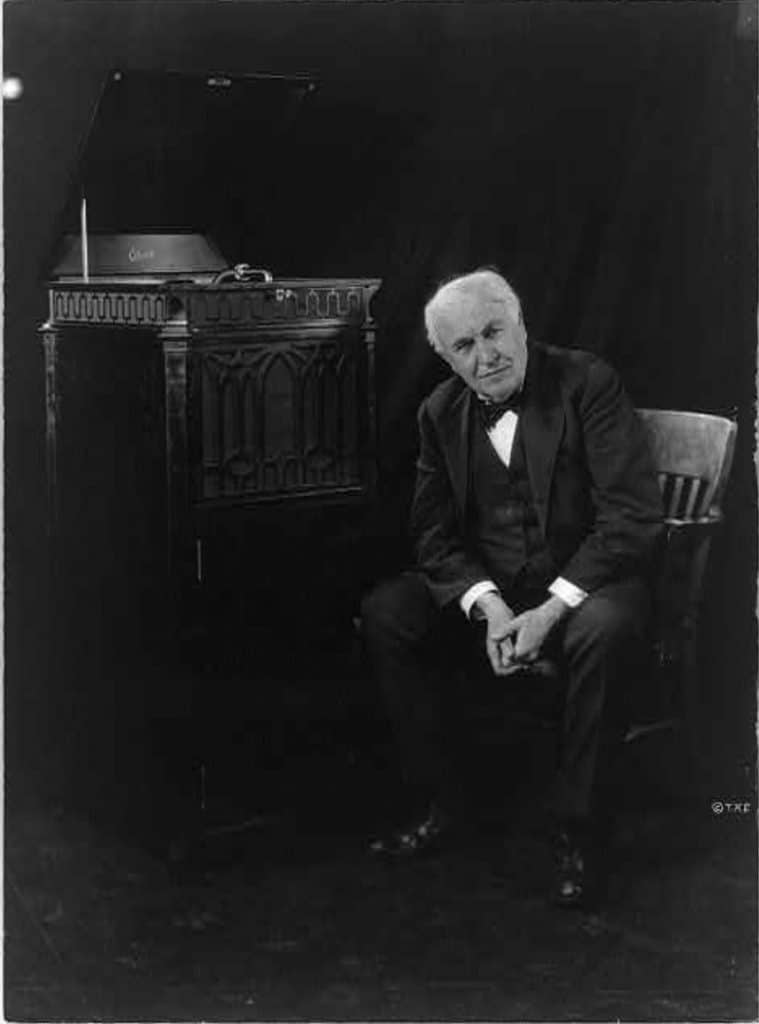
While Edison’s Disc Phonograph did have some moderate success based on the custom cabinets and sound, it was not enough in the end. The materials used to create the disc created problems as the resin would separate from the core, unlike the competitors’ shellac albums.
1924 hit the scene and with the introduction of the radio, Edison’s company began to struggle but by 1926 Edison offered new long-played records or LPs. As business struggled Edison entered the radio scene so he could offer radio phonographs in 1928 but by October of the following year, the closed the phonograph only portion of the business to focus on the radio phonographs.
For Berliner and Johnson in 1929, RCA purchased the Victor Talking Machine Company to establish RCA Victor. By 1931 they had produced the world’s first 33 and ⅓ RPM which featured similar grooves to their standard 78 RPM. There is a big distinction between RCA Victor’s 33 and ⅓ and the later released Columbia Long Play and that is the grooves.
Columbia Long Play records had microgrooves compared to the shallow wider grooves of this format. The biggest downfall for the format at that time was the fact people had to purchase new turntables. That may not seem like much of an issue except the great depression was in full force at this point so the priority of a record player or turntable that had both speeds at $400 was usually not a priority. In 1933 the format and the turntables were altogether abandoned and no longer offered.
While this was going on in 1931 Columbia Records merged with Gramophone Company Limited, Berliner’s United Kingdom company, to form EMI (Electric & Musical Industries Ltd) and began experimenting themselves with different formats and sizes of records. Both Columbia and RCA struggled with new sales and album sales during much of the great depression while working behind the scenes on various formats until the 1940s
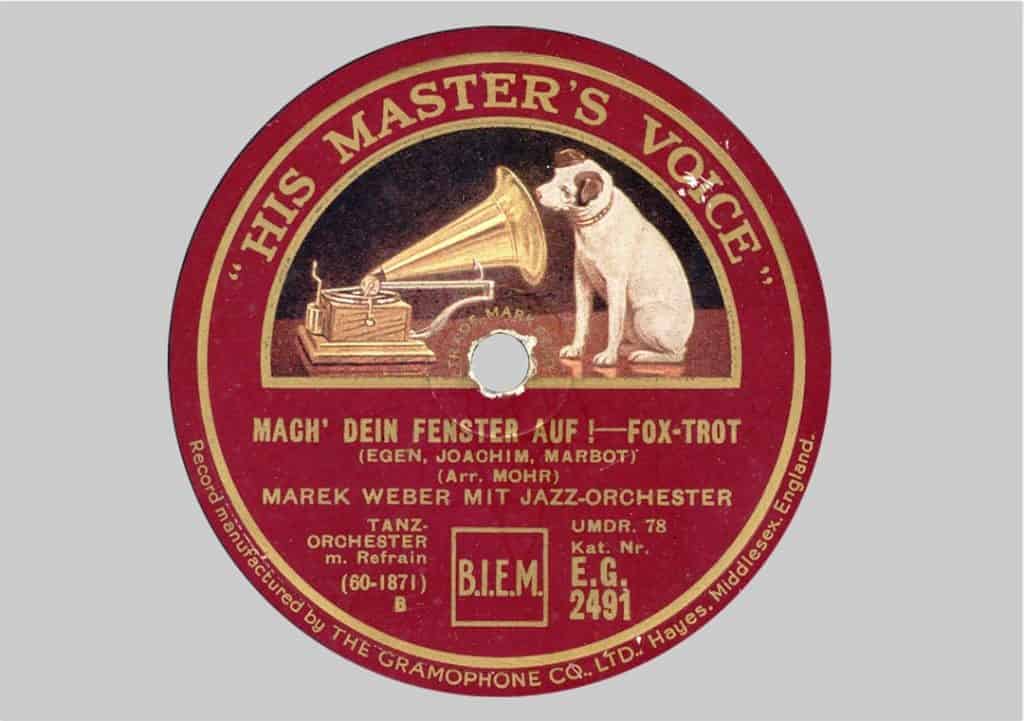
The Late History Of Vinyl Records and Record Players (1940s-1980s)
The 1940s was a big time for the US and the record industry. Being out of the Great Depression but swiftly moving into World War II was an intense moment. On December 7th, 1941 the Japanese led an attack on Pearl Harbor which put Americans in the fight. On September 2nd, 1945 World War II was over.
Record Players During World War II
During the war era, there was not much going on in terms of format changes or technology changes in the vinyl record and record player world. CBS acquired Columbia Records and was mostly busy with signing new artists like Frank Sinatra while Peter Goldmark’s team was busy developing a new product for the record industry. RCA Victor was dealing with a huge union strike (American Federation of Musicians) banning recording.
In June 1948 Columbia released the first-ever Long Play microgroove record that used 33 and ⅓. The reason this is a big deal is that this is the format we see and use to this day. This format development was led by Peter Goldmark with the engineering work from William Savory. This long play record, or LP record, was made of polyvinyl chloride. You read that right, vinyl records are made of polyvinyl chloride also known as PVC.
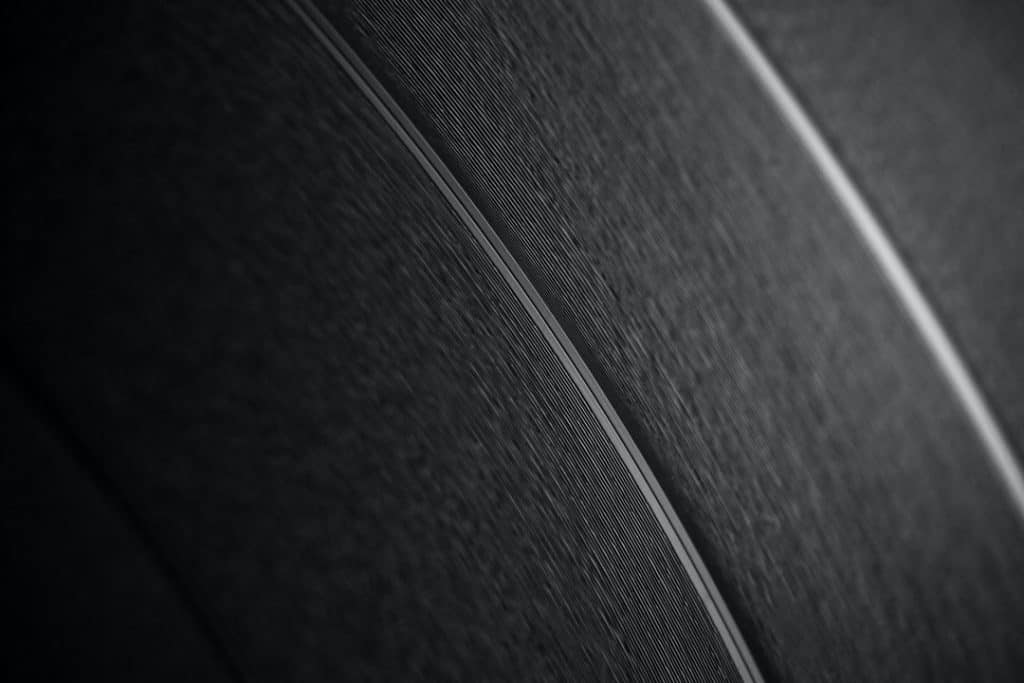
All the secret work in the early ’40s spent on developing these new LP records, was worth it for Columbia as it was a hit. People loved the idea of much longer records and the 12-inch vinyl record provided just that by offering closer grooves, larger size, and slower spinning.
In 1949 RCA Victor released their micro-grooved vinyl record marketed as the “45” which you still hear to this day. What people are referring to when they say “a 45” is a 7-inch vinyl record with a speed of 45 RPMs. While 45 technically describes the speed, not the record itself, people call it this because when the 7-inch 45 rpm was released, that’s how they marketed it. Even though RCA was busy working on this for years, it was released right after the long play record from Columbia, making it a competitor.
When they released the 45 they also marketed it as a replacement for their own 10 and 12-inch 78 RPM shellac records. While the old records could only hold 4 minutes per side, the new 7-inch 45 RPM records could hold 7 minutes per side, so they called them Extended Play records. That is where the term EP records or EP albums originated. Due to RCA Victor’s massive marketing efforts, 45’s quickly became the gold standard for singles.
By 1950 RCA Victor recognized the success Columbia had with its 33 and ⅓ LP and started producing their own LP’s. In 1951 Columbia also acknowledged the benefits and success of the 45 and began producing their own 45’s. Both companies began working on stereo recordings next and continued their growth which was not released in issues until 1958.
In 1954 RCA Victor introduced another game-changing piece of vinyl record technology and they called it “Gruve-Gard”. What Gruve-Gard did was make the records thicker on the outer edge and middle so that it would reduce scuff marks when stacked or being handled. This helped reduce scuffs and wear in automatic record changers. This was a feature that the competition quickly got on board with and also included in their records.
Most of the other changes in the industry in the ’50s were just business changes and contract changes but once the 1960s rolled around both CBS and RCA experimented with various tweaks of their vinyl records.
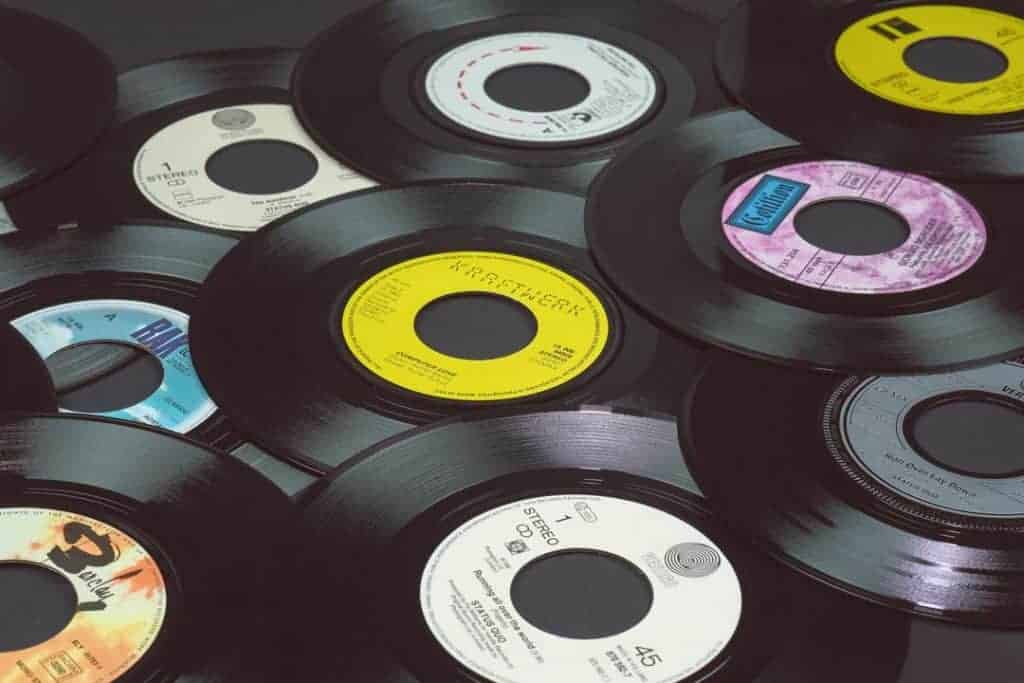
RCA decided in 1961 they wanted to attempt to replace the 45 with a 7-inch vinyl record that spun at 33 and ⅓ RPMs. They did this by releasing 45’s alongside the new 7-inch and it never took off. By 1962 they called their campaign a failure as sales were a bust. During this time Columbia was working on new machines for pressing their records.
In 1963 RCA tried releasing another new feature for vinyl that was a flop. They called it “Dynagroove” which added some computer technology to the cutting process which they claimed improved sound. They discontinued the Dynagroove by 1970.
The Almost Death Of Vinyl Record
With vinyl records being a huge hit there was still a problem they could not fill for customers and that was traveling and listening on the go. The radio was filling this void but you could not listen to your vinyl on demand in the car or on the go. That is where the 8 track came in. RCA was working hard on the 8 track and released the technology in 1965 and was first featured in Ford vehicles. Now, this is not an 8 track post so we will leave it there for now.
The last real technology or format change that came from the ’60s was in 1969 with RCA’s Dynaflex vinyl records. The goal was to reduce wear and warping by making a thinner more flexible vinyl record. The format was dropped within a year.
At this point, most things and new technology stood still. Vinyl records were a hit and everyone loved them. The most common records found were 12-inch 33 and ⅓ RPM and 7-inch 45 RPM. That is until the 80’s when the CD hit the market.
CDs had their first public release in 1982 and even though the first CD players made by Sony and Philips cost $1000 they sold around 400,000 units through 1984. By 1986 CD sales overtook vinyl records and began the ultimate downfall for vinyl records and by 1989 vinyl records mass production started to slow down as record sales continued to decline to CDs.
The Modern History Of Vinyl Records And History Of Record Players (1990’s – Modern Day)
The ’90s continued to see lower and lower sales of vinyl records as only audiophiles continued to buy and collect vinyl records. Production and sales got so bad that before the Vinyl Revival that’s going on now, there were only 3 manufacturers in the United States. Then something started to happen with CDs came MP3 rips of CDs. By the turn of the millennium sales of digital copies of albums began to overtake CD sales.
Vinyl Resurgence
Then in 2007 something started to happen. Sales of vinyl records started to increase for the first time in twenty years. This was a bit of a shock to the music industry as most of the albums they were selling and producing were picture discs and collectors editions for people who were looking for them. By 2008 sales had risen sharply to the extent that it was very noticeable.
We wrote a related post to this portion of the history lesson. Not to continue to drag this out, we think you should read that article. We will highlight a couple of key points as this is a part of the current history.
According to the Nielsen Music’s Year-End 2019 Report, total album consumption was up 14% over 2018 mostly pushed by streaming services. However, even though total album sales were down by 18.7% vinyl made a record for itself. At 16.7% of total albums sold in 2019 up from 11.9% in 2018, vinyl accounted for a staggering 25.6% of all physical albums sold. According to Midyear Report from Nielsen Music for 2020 even during a worldwide pandemic, vinyl record sales are up 45% from this time last year.
That’s all we have for our history on vinyl records and record players. We find it interesting that in a time that we have access to anything in an instant, the world seems to be returning to a simpler time with the music. A time when music was about an experience and about sharing that experience with each other.

